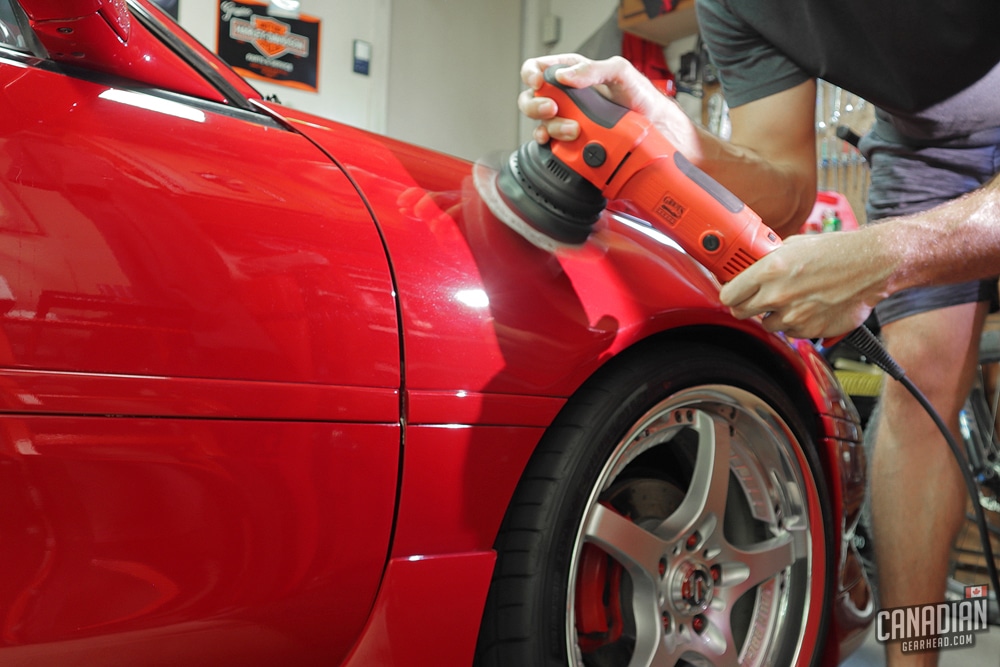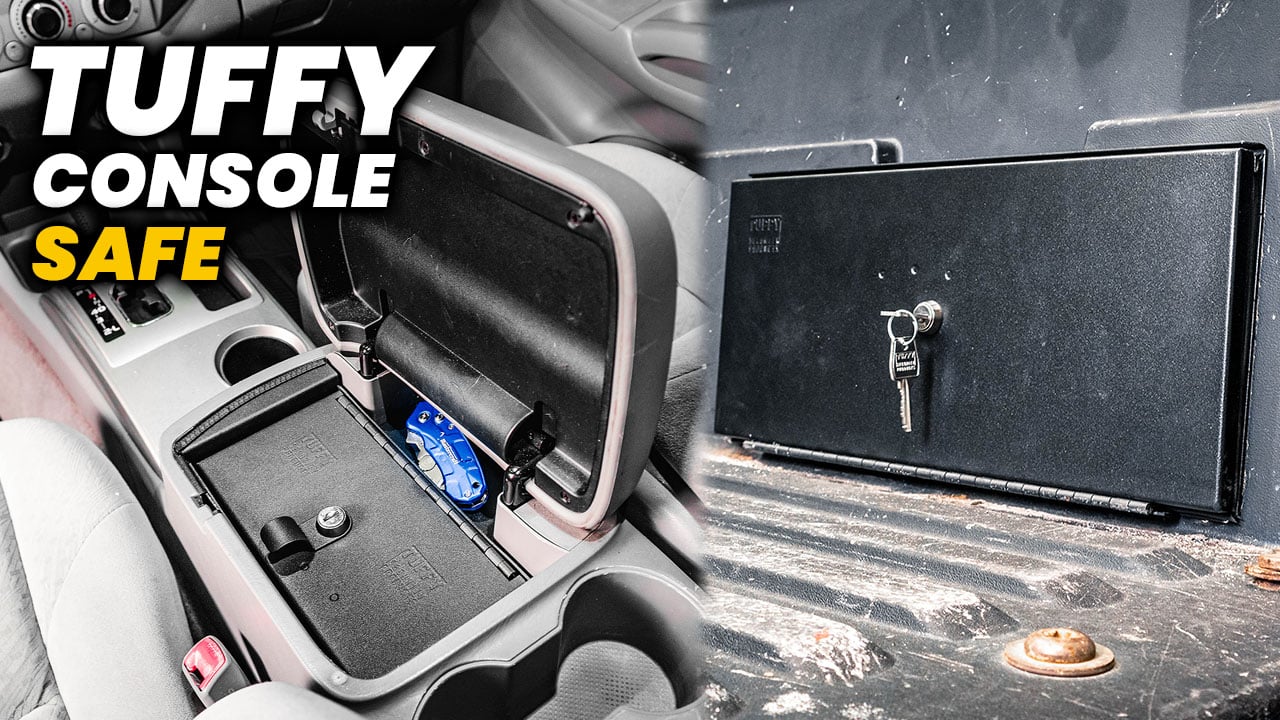There seems to be a lot of confusion out there when it comes to paint protection film (also known as clear bra or PPF for short). Can it be used in conjunction with a ceramic coating? What happens if swirl marks and scratches begin to develop in it?
Paint protection film can be polished if necessary. It can be treated much like polishing a paint job except with a little extra care. A ceramic coating can be applied over top of the PPF but there are some instances where it’s not recommended, such as with some self-healing films.
Polishing a car with paint protection film
PPF can be polished much the same as your paint job. You might be wondering why polishing would be needed since its job is to protect the paint from scratches and chips. While that is indeed true, there are minor instances where the film itself doesn’t need to be replaced – it just needs a bit of a refresh.
Paint protection film can begin to look dull over the years and it can also develop swirl marks from improper washing methods (just like your paint). If you have a self-healing film, simply heating it up will often get rid of swirl marks and even more moderate scratches. That’s the main selling point to those higher priced options.
For more traditional clear bras, there are 2 options when it starts to look worn out – replace it or polish it. Of course, if it’s really weathered, it’s probably best to just replace it with brand new film. But before spending all of the time and money to do that, it’s worth at least attempting to polish it first. You might be surprised at the results.
As with any type of machine polishing, always start with the least aggressive pad and polish combination and work up from there. The overall idea might be the same but some extra care is needed, so pay attention.
Avoid overheating the film
Getting the PPF too hot can be a big concern when polishing it. You should always be managing heat when polishing your paint but be extra careful when polishing the film. Remember that a) the film dissipates heat differently than painted metal and b) the film is held on by adhesive. Overheating it can result in the film burning or even losing adhesion to the paint.

Be careful near edges
The thing with paint protection film is that it needs to start and end somewhere. There are some situations where it can be wrapped all the way around the edge of a panel but there are many cases where having a hard edge is unavoidable. It also depends on the skill level of the installer as far as whether the edges will be wrapped or not.
Just like with any other sticker, it isn’t hard to peel it up when your polishing pad grabs an edge. It’s best to place tape along the edge and/or keep your buffer 1″ away from it at all times.
Polishing self-healing films should only be done if absolutely necessary. There is a risk of degrading the self-healing coating of the film. In most cases, pouring hot water on it or leaving it in the sun for a few hours will correct any swirl marks that you feel the need to polish out anyway.
What products to use to polish paint protection film
If you’re going to polish your PPF, it’s important to choose your products wisely. Using something that’s too aggressive can leave a haze behind.
Sticking with a foam pad for your buffer instead of a microfiber or wool pad is a good idea. The foam pad is smoother and won’t have the individual fibers reaching around and pulling on the edge of the film. It’s also handy that most foam pads are on the less aggressive side when compared to others which will reduce the risk of a hazy finish after polishing.
As for polishes, a finishing polish will be the least aggressive option so start there. Any polish or compound that you use on your paint can be used on the film, but again, the more aggressive you go, the more chance you have of leaving a haze behind.
Gyeon has a one-step polish and sealant called PPF Renew that was formulated specifically for use on paint protection films – even the self-healing ones. It has SI02 in it just like most ceramic coatings so it leaves behind some of those easy cleaning properties without affecting the film negatively.
Can you ceramic coat over paint protection film?
Paint protection film and ceramic coating are compared to each other all the time. Both have their pros and cons (and perhaps we’ll get into that in another article). What if you combine the 2 together for the best of both worlds – is that possible?
The truth is, you can apply a ceramic coating on top of paint protection film. This will give you thicker protection against chips and scratches while taking advantage of the easy cleaning characteristics of a coating.
You can’t however, apply paint protection over the top of a ceramic coated paint job. Having ceramic coating under PPF will cause the surface to be far too slick and the film won’t be able to adhere to it properly.

Applying a ceramic coating over PPF requires no additional attention in comparison to applying it on bare paint. It’s the same process – just wipe it on, allow it to flash, then remove any excess product with a towel.
It’s possible that a ceramic coating could affect the characteristics of a self-healing film though. Scratches can be removed from these by heating them up and having a coating over top could keep it from doing its job.
More than likely, the coating is just covering up those characteristics, not removing them. So in the event that it causes problems, the coating could be removed and the film underneath would still perform as intended.
Luckily, both the leaders in the PPF industry (Xpel and Suntek) have stated that applying a coating on top of their films is perfectly safe and won’t void the warranty.
You can feel free to use the same ceramic coating on your clear bra or PPF that you use on the rest of your car. If you’re concerned with how it will react with the film’s self-healing characteristics, you can use a coating like Gtechniq Halo. It’s been formulated specifically for use on paint protection film – even the self-healing ones.
How long does paint protection film last?
As with any other protective products, the lifespan of your PPF will depend on how you care for it and the type of use your car sees. A garage kept vehicle that’s washed carefully will surely have a different experience than a daily driver that is run through car washes and left outside.
Here is a simple table comparing the warranties of some of the top films on the market:
| Product | Warranty |
|---|---|
| Xpel Ultimate Plus | 10 years |
| SunTek PPF Ultra | 10 years |
| 3M Scotchgard | 10 years |
| Stek PROshield | 5 years |
| Stek DYNOshield | 10 years |
| PremiumShield Elite | 5 years |
| PremiumShield Elite Self Healing | Lifetime |
| Llumar PPF | 5 years |
How to maintain paint protection film
Proper maintenance is the key to making your PPF last as long as possible. Of course, the less time it spends out in the direct, hot sun, the better. Storing your car indoors is a good idea.
Use the same products you use on the rest of your paint to wash it. That includes PH-neutral soap, a soft wash mitt, high-quality microfiber towels, and safe wash methods.
If you’re using a pressure washer, be extra careful around the edges. You shouldn’t be using more than 1,000 psi anyway but if you’re using something more aggressive, make sure to stand back a few feet.
Don’t leave stains on the film for any longer than necessary. The quicker you can remove acidic things like bug splatter and bird droppings, the better. These things can etch into the film over time if left for too long, can cause permanent damage.
Try to keep the edges clean because the more dirt and grime build up there, the more noticeable they become. One of the biggest complaints about PPF is the visible edges – keeping them clean will help with that. Use a microfiber cloth and avoid scrubbing too hard on them.
You can use a wax or paint sealant over the top of your PPF if you want. It’ll add a small amount of extra protection and make it easier to keep clean. As mentioned above, ceramic coatings are generally permitted for use over paint protection film as well.
Paint protection film turning yellow – what to do?
If your paint protection film or clear bra is noticeably turning yellow, that indicates that it has failed and needs to be replaced. This isn’t typically an issue with modern films which is why most of them offer a 10+ year warranty against defects like yellowing.
Older films and some that are applied by car manufacturers at the factory will turn yellow over time. It’s often caused by the adhesive underneath the film becoming oxidized by the sun’s UV rays.
Yellowing can be more noticeable on lighter color cars. If you’re experiencing this, the only way to fix it is to replace the film with a new one.
Conclusion
As long as you choose a high-quality paint protection film, you can treat it just like the other painted surfaces of your car. Always be careful around the edges though whether you’re cleaning or polishing it. In the event that you’re unsure of how to care for your PPF, make sure to get advice from the person who installed it.
This post is part of our series on the truth behind ceramic coatings.

Tim is the creator of Canadian Gearhead. His experience with auto detailing and working for Toyota shows through all of the articles posted here. He runs the Canadian Gearhead site and YouTube channel full-time now and currently owns a 2007 4runner, 2006 Tacoma, and 1991 MR2. Read more about Tim:





Leave a Reply